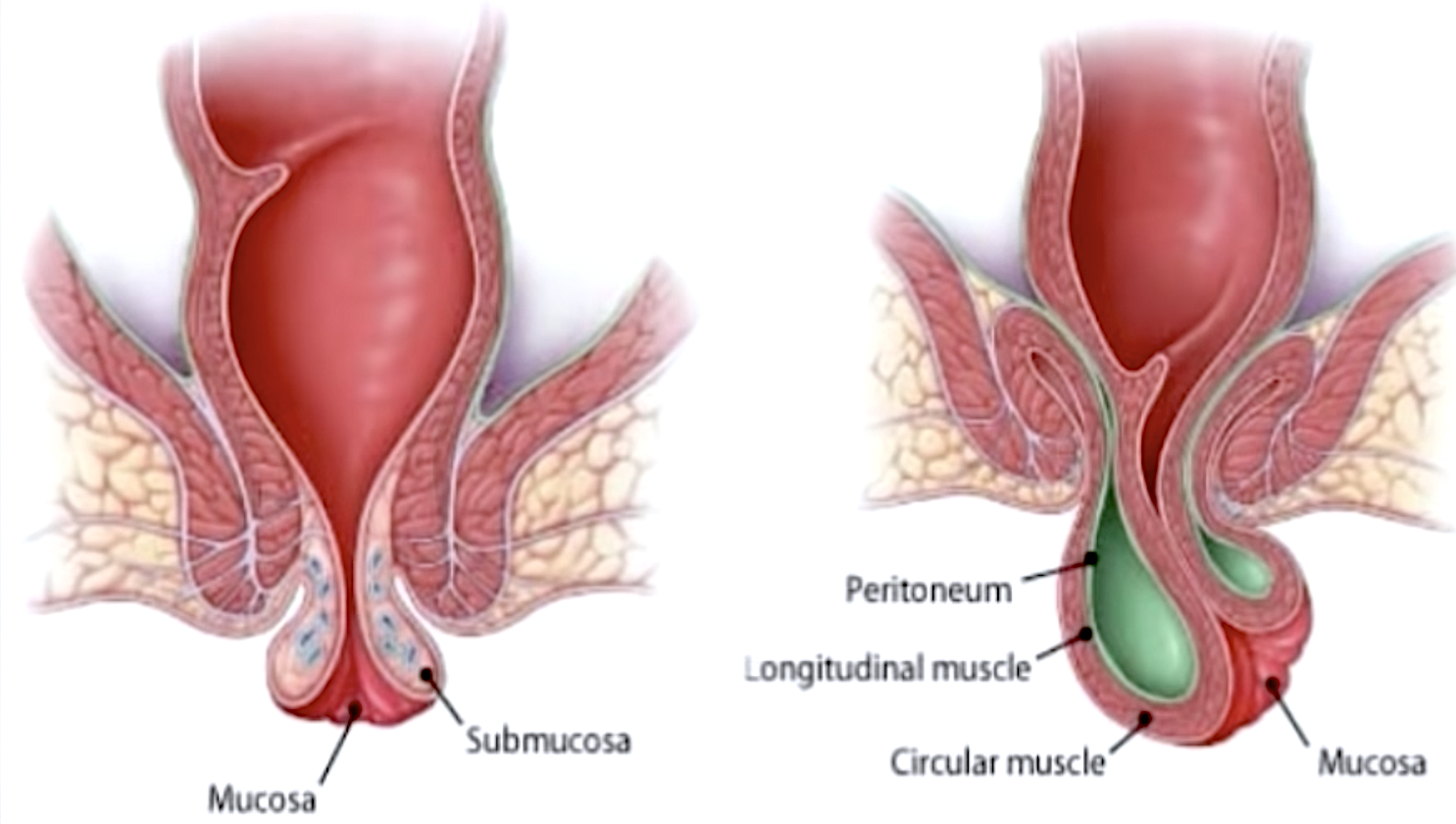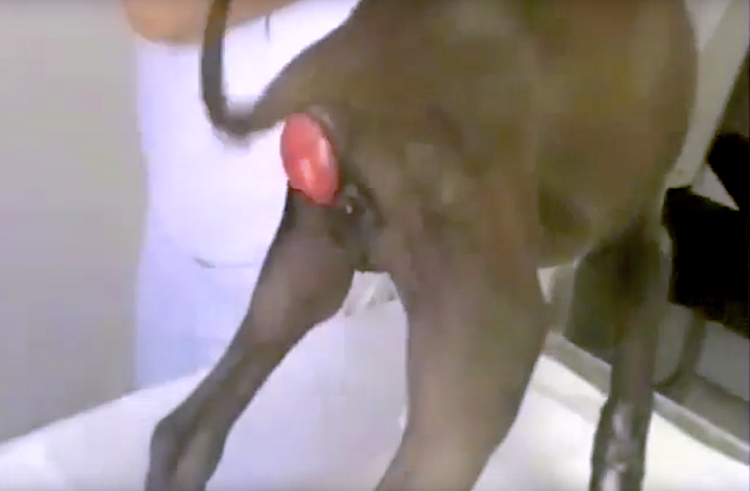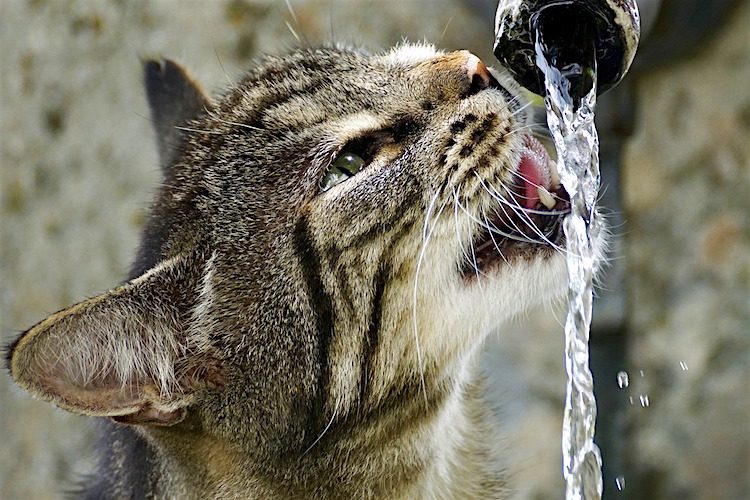
Rectal prolapse in dogs and cats occurs when the animal’s rectum (the last part of the digestive tract, where feces sits before it’s launched onto an unsuspecting world) pops out of the anus.
There’s little mistaking a rectal prolapse in a dogs or cat because it looks like a long, pink sausage or pink donut hanging out of the patient’s backside.
Apart from the obvious inconvenience to the pet, this is a serious problem because the delicate lining of the bowel is exposed to the elements.
With prompt action, the prolapse can be popped back into place by a veterinarian and there are steps to take to stop it from happening again.
Without treatment, though, the prolapsed tissue can develop serious, life-threatening complications.
Muscosal Prolapse vs. Full Rectal Prolapse in Dogs and Cats

Mucosal Prolapse: Usually Temporary
Let’s look now at what we call “mucosal prolapse” versus a “full rectal prolapse” in dogs and cats.
You may notice that occasionally your cat or dog has a pink rosette of tissue around the anus just after they’ve toileted. This is most likely what’s called everted rectal mucosa — a frill of moist mucosa that popped out.
Everted rectal mucosa (mucosal prolapse) is usually a temporary affair. It pops back inside once the pet has pooped. It usually happens because the poop drags on the lining of the rectum. If this regularly happens to your pet, then check that their poop isn’t too hard.
How to Soften Your Pet’s Stool
If your pet with a pink bottom has hard poop, then take steps to soften their stool. Options to discuss with your vet include:
1. Switch from dry kibble to wet food.
2. Add fiber to the diet (especially dogs).
- Give vegetables to chew on.
- Add canned pumpkin to their food.
- Sprinkle wheat bran on their meal.
- Use fecal bulking agents such as Peridale granules.
3. Encourage your pet to drink more water.
- Give access to a pet drinking fountain.
- Have multiple water bowls throughout the house.
- Have a water bowl next to the pet’s bed.
- Offer noncarbonated mineral water (this often tastes nicer than tap water).
- Add water to the pet’s food.
Full Rectal Prolapse in Dogs and Cats: It’s an Emergency
So now that we’ve covered mucosal prolapse, let’s look at the more serious version: the full rectal prolapse.
Let’s say the worst has happened: You come home to find a “pink sausage” sticking out of your dog’s butt. What do you do?
Your dog needs immediate veterinary treatment.
Don’t delay — contact an emergency vet and go to the clinic, but take steps to prevent damage to the delicate tissue of the rectum:
- Stop the animal from licking the area.
- Keep the prolapse moist. Saturate some cotton swabs in saline solution (such as contact lens solution). Gently wrap this around the prolapse to protect the tissue. Then wet the swabs some more so they stay moist.
- Don’t feed your pet: The pet will need an anesthetic, so an empty stomach is essential.
Now, get to the vet!

Risk Factors for Prolapse
Prolapses are most common in young animals, such as puppies and kittens.
This could be because the valve (anal ring) guarding the anus is weak in these younger animals.
Rectal prolapse is also strongly linked to straining, so the pet may have severe constipation, diarrhea or urinary problems.
Was YOUR Pet Food Recalled?
Check Now: Blue Buffalo • Science Diet • Purina • Wellness • 4health • Canine Carry Outs • Friskies • Taste of the Wild • See 200+ more brands…

Common causes of straining that lead to rectal prolapse in dogs and cats include:
- Severe diarrhea, caused by infection
- Intestinal parasites
- Food allergy or intolerance
- Foreign bodies in the rectum (such as bone shards)
- Colitis (inflammation of the large bowel)
- Cystitis or urinary tract disease
- Straining to give birth
Help your pet by making sure they are dewormed regularly, and get prompt treatment for diarrhea.

Treating a Rectal Prolapse in a Dog or Cat
Although this condition is rare, I recently treated both a dog and a cat for rectal prolapses. Both of them had an anesthetic and the prolapsed tissue gently replaced.
There’s a risk of immediate re-prolapse, so a purse-string suture was placed so this physically can’t happen.
This suture is exactly what it sounds like: It tightens the anus in the same way a drawstring closes a shoe bag. A small hole is left so soft poop can pass through, and the suture is removed after about 7 days.
The vigilant among you will spot that normal poop won’t pass through a small hole. This makes it necessary to use a gentle laxative, such as lactulose, to keep things soft.
Unfortunately for my feline patient, the client overlooked giving the lactulose, so the cat became very uncomfortable.
This meant intervention with an enema. Now we’re waiting for things to settle down before removing that purse-string suture and hoping that the cat’s rectum stays in place.
And what happens if the purse-string suture doesn’t work?
Then things would get very serious. It would mean radical surgery to amputate the prolapsed tissue. But, as you can imagine, this is high-risk surgery that’s prone to complications, so it’s best avoided.
Final Thoughts
Monitor your pet for straining, and get help if things aren’t right.
Not to do so risks complications such as a rectal prolapse in your dog or cat — which, although rare, does happen.
References
- Rubin, Stanley I., DVM, DACVIM. “Rectal Prolapse.” Merck Veterinary Manual. https://www.msdvetmanual.com/digestive-system/diseases-of-the-rectum-and-anus/rectal-prolapse.
- “Rectal Prolapse in Dogs.” PetCoach. https://www.petcoach.co/dog/condition/rectal-prolapse/.
 This pet health content was written by a veterinarian, Dr. Pippa Elliott, BVMS, MRCVS. It was last reviewed Jan. 19, 2018.
This pet health content was written by a veterinarian, Dr. Pippa Elliott, BVMS, MRCVS. It was last reviewed Jan. 19, 2018. 

